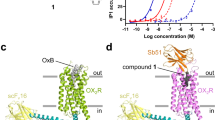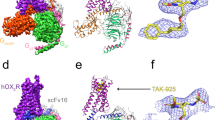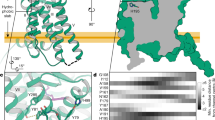Abstract
The orexin (also known as hypocretin) G protein-coupled receptors (GPCRs) respond to orexin neuropeptides in the central nervous system to regulate sleep and other behavioural functions in humans1. Defects in orexin signalling are responsible for the human diseases of narcolepsy and cataplexy; inhibition of orexin receptors is an effective therapy for insomnia2. The human OX2 receptor (OX2R) belongs to the β branch of the rhodopsin family of GPCRs3, and can bind to diverse compounds including the native agonist peptides orexin-A and orexin-B and the potent therapeutic inhibitor suvorexant4. Here, using lipid-mediated crystallization and protein engineering with a novel fusion chimaera, we solved the structure of the human OX2R bound to suvorexant at 2.5 Å resolution. The structure reveals how suvorexant adopts a π-stacked horseshoe-like conformation and binds to the receptor deep in the orthosteric pocket, stabilizing a network of extracellular salt bridges and blocking transmembrane helix motions necessary for activation. Computational docking suggests how other classes of synthetic antagonists may interact with the receptor at a similar position in an analogous π-stacked fashion. Elucidation of the molecular architecture of the human OX2R expands our understanding of peptidergic GPCR ligand recognition and will aid further efforts to modulate orexin signalling for therapeutic ends.
This is a preview of subscription content, access via your institution
Access options
Subscribe to this journal
Receive 51 print issues and online access
$199.00 per year
only $3.90 per issue
Buy this article
- Purchase on Springer Link
- Instant access to full article PDF
Prices may be subject to local taxes which are calculated during checkout



Similar content being viewed by others
References
Li, J., Hu, Z. & de Lecea, L. The hypocretins/orexins: integrators of multiple physiological functions. Br. J. Pharmacol. 171, 332–350 (2014)
Michelson, D. et al. Safety and efficacy of suvorexant during 1-year treatment of insomnia with subsequent abrupt treatment discontinuation: a phase 3 randomised, double-blind, placebo-controlled trial. Lancet Neurol. 13, 461–471 (2014)
Fredriksson, R., Lagerström, M. C., Lundin, L.-G. & Schiöth, H. B. The G-protein-coupled receptors in the human genome form five main families. Phylogenetic analysis, paralogon groups, and fingerprints. Mol. Pharmacol. 63, 1256–1272 (2003)
Winrow, C. J. & Renger, J. J. Discovery and development of orexin receptor antagonists as therapeutics for insomnia. Br. J. Pharmacol. 171, 283–293 (2014)
Zhu, Y. et al. Orexin receptor type-1 couples exclusively to pertussis toxin-insensitive G-proteins, while orexin receptor type-2 couples to both pertussis toxin-sensitive and -insensitive G-proteins. J. Pharmacol. Sci. 92, 259–266 (2003)
Lin, L. et al. The sleep disorder canine narcolepsy is caused by a mutation in the hypocretin (orexin) receptor 2 gene. Cell 98, 365–376 (1999)
Chemelli, R. M. et al. Narcolepsy in orexin knockout mice: molecular genetics of sleep regulation. Cell 98, 437–451 (1999)
Nishino, S., Ripley, B., Overeem, S., Lammers, G. J. & Mignot, E. Hypocretin (orexin) deficiency in human narcolepsy. Lancet 355, 39–40 (2000)
Cox, C. D. et al. Discovery of the dual orexin receptor antagonist [(7R)-4-(5-chloro-1,3-benzoxazol-2-yl)-7-methyl-1,4-diazepan-1-yl][5-methyl-2-(2H-1,2,3-triazol-2-yl)phenyl]methanone (MK-4305) for the treatment of insomnia. J. Med. Chem. 53, 5320–5332 (2010)
Rosenbaum, D. M. et al. GPCR engineering yields high-resolution structural insights into 2-adrenergic receptor function. Science 318, 1266–1273 (2007)
Warne, T. et al. Structure of a β1-adrenergic G-protein-coupled receptor. Nature 454, 486–491 (2008)
Caffrey, M. Crystallizing membrane proteins for structure determination: use of lipidic mesophases. Annu. Rev. Biophys. 38, 29–51 (2009)
White, J. F. et al. Structure of the agonist-bound neurotensin receptor. Nature 490, 508–513 (2012)
Egloff, P. et al. Structure of signaling-competent neurotensin receptor 1 obtained by directed evolution in Escherichia coli. Proc. Natl Acad. Sci. USA 111, E655–E662 (2014)
Horcajada, C., Guinovart, J. J., Fita, I. & Ferrer, J. C. Crystal structure of an archaeal glycogen synthase: insights into oligomerization and substrate binding of eukaryotic glycogen synthases. J. Biol. Chem. 281, 2923–2931 (2006)
Manglik, A. et al. Crystal structure of the µ-opioid receptor bound to a morphinan antagonist. Nature 485, 321–326 (2012)
Wu, B. et al. Structures of the CXCR4 chemokine GPCR with small-molecule and cyclic peptide antagonists. Science 330, 1066–1071 (2010)
Malherbe, P. et al. Mapping the binding pocket of dual antagonist almorexant to human orexin 1 and orexin 2 receptors: comparison with the selective OX1 antagonist SB-674042 and the selective OX2 antagonist N-ethyl-2-[(6-methoxy-pyridin-3-yl)-(toluene-2-sulfonyl)-amino]-N-pyridin-3-ylmethyl-acetamide (EMPA). Mol. Pharmacol. 78, 81–93 (2010)
Kruse, A. C. et al. Structure and dynamics of the M3 muscarinic acetylcholine receptor. Nature 482, 552–556 (2012)
Ballesteros, J. A. Activation of the β2-adrenergic receptor involves disruption of an ionic lock between the cytoplasmic ends of transmembrane segments 3 and 6. J. Biol. Chem. 276, 29171–29177 (2001)
Bokoch, M. P. et al. Ligand-specific regulation of the extracellular surface of a G-protein-coupled receptor. Nature 463, 108–112 (2010)
Rasmussen, S. G. F. et al. Structure of a nanobody-stabilized active state of the β2 adrenoceptor. Nature 469, 175–180 (2011)
Kruse, A. C. et al. Activation and allosteric modulation of a muscarinic acetylcholine receptor. Nature 504, 101–106 (2013)
Cox, C. D. et al. Conformational analysis of N,N-disubstituted-1,4-diazepane orexin receptor antagonists and implications for receptor binding. Bioorg. Med. Chem. Lett. 19, 2997–3001 (2009)
Sakurai, T. et al. Orexins and orexin receptors: a family of hypothalamic neuropeptides and G protein-coupled receptors that regulate feeding behavior. Cell 92, 573–585 (1998)
Kolb, P. et al. Structure-based discovery of β2-adrenergic receptor ligands. Proc. Natl Acad. Sci. USA 106, 6843–6848 (2009)
Brisbare-Roch, C. et al. Promotion of sleep by targeting the orexin system in rats, dogs and humans. Nature Med. 13, 150–155 (2007)
Malherbe, P. et al. Biochemical and behavioural characterization of EMPA, a novel high-affinity, selective antagonist for the OX2 receptor. Br. J. Pharmacol. 156, 1326–1341 (2009)
Langmead, C. J. et al. Characterisation of the binding of [3H]-SB-674042, a novel nonpeptide antagonist, to the human orexin-1 receptor. Br. J. Pharmacol. 141, 340–346 (2004)
Tran, D.-T. et al. Chimeric, mutant orexin receptors show key interactions between orexin receptors, peptides and antagonists. Eur. J. Pharmacol. 667, 120–128 (2011)
Kobilka, B. K. Amino and carboxyl terminal modifications to facilitate the production and purification of a G protein-coupled receptor. Anal. Biochem. 231, 269–271 (1995)
Caffrey, M. & Cherezov, V. Crystallizing membrane proteins using lipidic mesophases. Nature Protocols 4, 706–731 (2009)
Otwinowski, Z. & Minor, W. Processing of X-ray diffraction data collected in oscillation mode. Methods Enzymol. 276, 307–326 (1997)
McCoy, A. J. et al. Phaser crystallographic software. J. Appl. Crystallogr. 40, 658–674 (2007)
Adams, P. D. et al. PHENIX: a comprehensive Python-based system for macromolecular structure solution. Acta Crystallogr. D 66, 213–221 (2010)
Cowtan, K. Fitting molecular fragments into electron density. Acta Crystallogr. D 64, 83–89 (2008)
Emsley, P., Lohkamp, B., Scott, W. G. & Cowtan, K. Features and development of Coot. Acta Crystallogr. D 66, 486–501 (2010)
Painter, J. & Merritt, E. A. TLSMD web server for the generation of multi-group TLS models. J. Appl. Crystallogr. 29, 109-–111 (2006)
Schüttelkopf, A. W. & van Aalten, D. M. F. PRODRG: a tool for high-throughput crystallography of protein-ligand complexes. Acta Crystallogr. D 60, 1355–1363 (2004)
Chen, V. B. et al. MolProbity: all-atom structure validation for macromolecular crystallography. Acta Crystallogr. D 66, 12–21 (2010)
Rocchia, W., Alexov, E. & Honig, B. Extending the applicability of the nonlinear Poisson–Boltzmann equation: multiple dielectric constants and multivalent ions. J. Phys. Chem. B 105, 6507–6514 (2001)
Wallace, A. C., Laskowski, R. A. & Thornton, J. M. LIGPLOT: a program to generate schematic diagrams of protein-ligand interactions. Protein Eng. 8, 127–134 (1995)
Irwin, J. J. et al. Automated docking screens: a feasibility study. J. Med. Chem. 52, 5712–5720 (2009)
Mysinger, M. M. & Shoichet, B. K. Rapid context-dependent ligand desolvation in molecular docking. J. Chem. Inf. Model. 50, 1561–1573 (2010)
Morris, G. M. et al. AutoDock4 and AutoDockTools4: automated docking with selective receptor flexibility. J. Comput. Chem. 30, 2785–2791 (2009)
Kirchmair, J., Wolber, G., Laggner, C. & Langer, T. Comparative performance assessment of the conformational model generators Omega and Catalyst: a large-scale survey on the retrieval of protein-bound ligand conformations. J. Chem. Inf. Model. 46, 1848–1861 (2006)
Neudert, G. & Klebe, G. DSX: a knowledge-based scoring function for the assessment of protein-ligand complexes. J. Chem. Inf. Model. 51, 2731–2745 (2011)
Acknowledgements
We acknowledge support from the Welch Foundation (I-1770 to D.M.R.), the Searle Scholars Program (D.M.R.), a Packard Foundation Fellowship (D.M.R.), an Emmy Noether Fellowship of the German Research Foundation (KO-4095/1-1 to P.K.) and COST Action GLISTEN (CM1207 to P.K.). We thank D. Borek and Z. Otwinowski for assistance with diffraction data processing. The National Institute of General Medical Sciences and National Cancer Institute Structural Biology Facility at the Advanced Photon Source is funded in whole or in part with federal funds from the National Cancer Institute (ACB-12002) and the National Institute of General Medical Sciences (AGM-12006).
Author information
Authors and Affiliations
Contributions
J.Y. expressed, purified and crystallized the hOX2R–PGS fusion protein, collected diffraction data, and solved the structure. J.C.M. performed computational docking experiments on synthetic orexin receptor antagonists. P.K. supervised and performed computational docking experiments. D.M.R. supervised the overall project, assisted with collection of diffraction data and wrote the manuscript. All authors discussed the results and commented on the manuscript.
Corresponding author
Ethics declarations
Competing interests
The authors declare no competing financial interests.
Extended data figures and tables
Extended Data Figure 1 Purification of crystallization-grade hOX2R–PGS.
a, Superdex 200 gel filtration profile of hOX2R–PGS purified by nickel immobilized-metal affinity chromatography (Ni-IMAC) and M1-Flag immunoaffinity chromatography. b, Coommassie-stained polyacrylamide gel electrophoresis (PAGE) of the isolated peak fraction from gel filtration.
Extended Data Figure 2 Lipidic cubic phase crystallization setup for hOX2R–PGS.
The image shows representative microcrystals of the hOX2R–PGS protein that were harvested to produce high-resolution diffraction.
Extended Data Figure 3 Electron density map for suvorexant and surrounding residues.
The 2Fo − Fc electron density map is contoured at 1.2σ.
Extended Data Figure 4 Sequence alignment between hOX2R and hOX1R.
Positions that are identical between the two receptors are highlighted with a red background.
Extended Data Figure 5 Conservation of the orthosteric binding pocket between hOX2R and hOX1R.
Structure of the extracellular region of hOX2R, with residues that are identical between hOX2R and hOX1R coloured red, and residues that are different coloured grey. T1112.61 (to Ser) and T1353.33 (to Ala) are the only residues within 6 Å of suvorexant that are different between the two GPCRs. ECL3 is removed for clarity.
Extended Data Figure 6 Alternative docked poses for almorexant and EMPA.
a, Left, chemical structure of almorexant. Right, second docked pose of almorexant (green carbons) that was favourably scored and in agreement with mutational data. b, Left, chemical structure of EMPA. Right, second docked pose of EMPA (cyan carbons) that was favourably scored and in agreement with mutational data.
Supplementary information
Supplementary Information
This file contains descriptions of docking poses in Figure 3 and Extended Data Figure 6. (PDF 87 kb)
Rights and permissions
About this article
Cite this article
Yin, J., Mobarec, J., Kolb, P. et al. Crystal structure of the human OX2 orexin receptor bound to the insomnia drug suvorexant. Nature 519, 247–250 (2015). https://doi.org/10.1038/nature14035
Received:
Accepted:
Published:
Issue Date:
DOI: https://doi.org/10.1038/nature14035
This article is cited by
-
Characterization of a putative orexin receptor in Ciona intestinalis sheds light on the evolution of the orexin/hypocretin system in chordates
Scientific Reports (2024)
-
Universal platform for the generation of thermostabilized GPCRs that crystallize in LCP
Nature Protocols (2022)
-
Orexin Receptor Antagonists and Insomnia
Current Psychiatry Reports (2022)
-
Ligand binding at the protein–lipid interface: strategic considerations for drug design
Nature Reviews Drug Discovery (2021)
-
Structures of active-state orexin receptor 2 rationalize peptide and small-molecule agonist recognition and receptor activation
Nature Communications (2021)
Comments
By submitting a comment you agree to abide by our Terms and Community Guidelines. If you find something abusive or that does not comply with our terms or guidelines please flag it as inappropriate.



